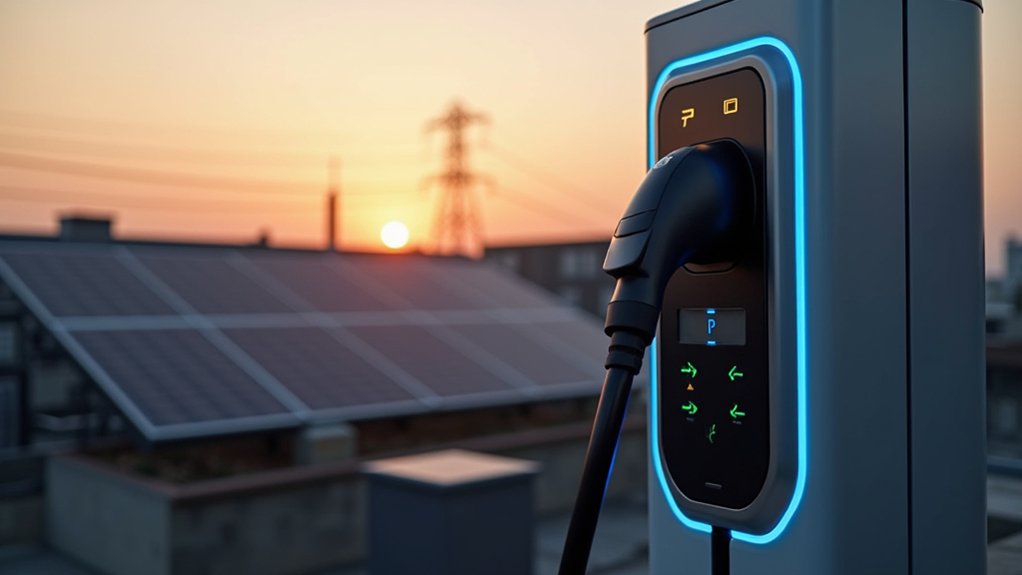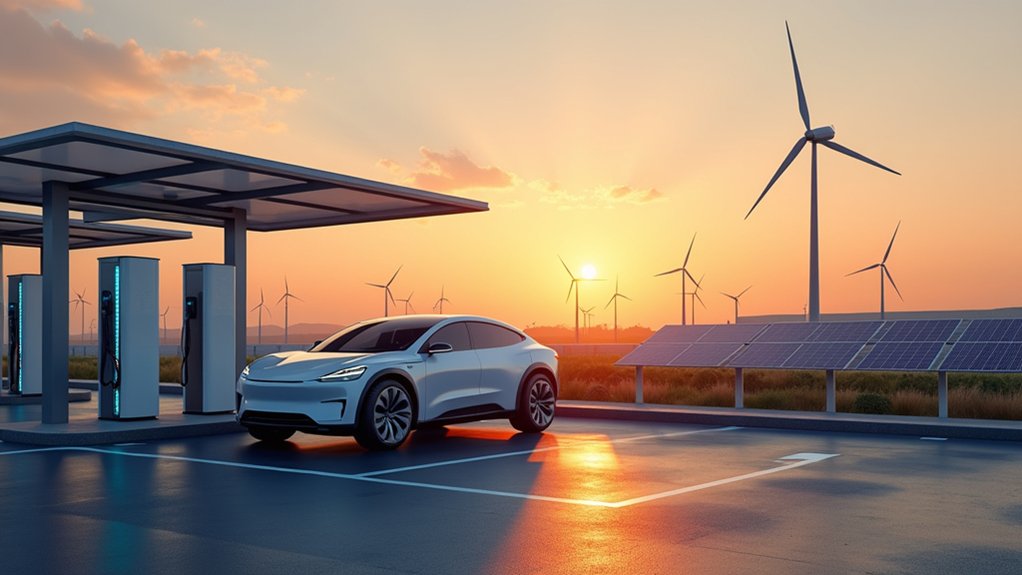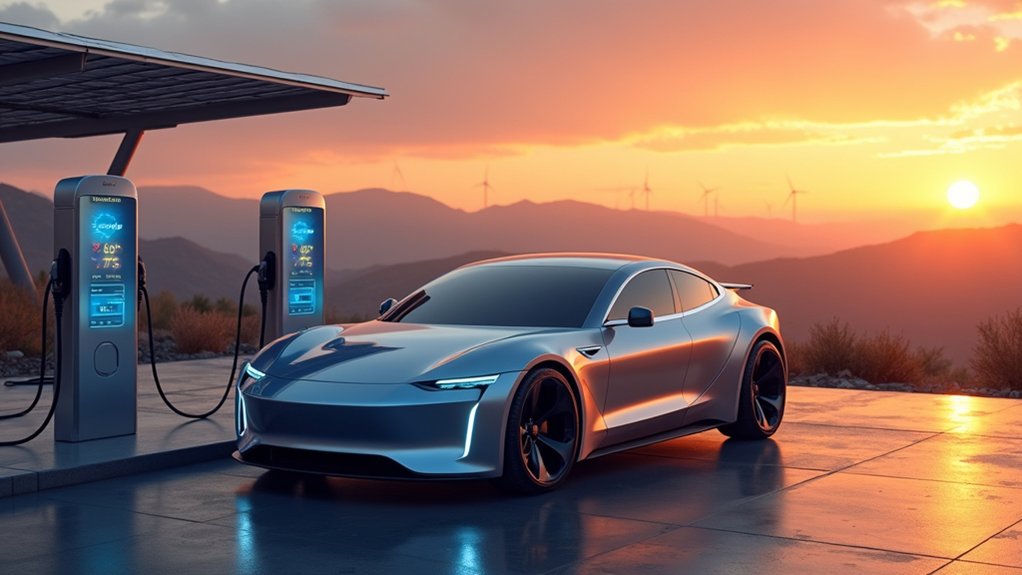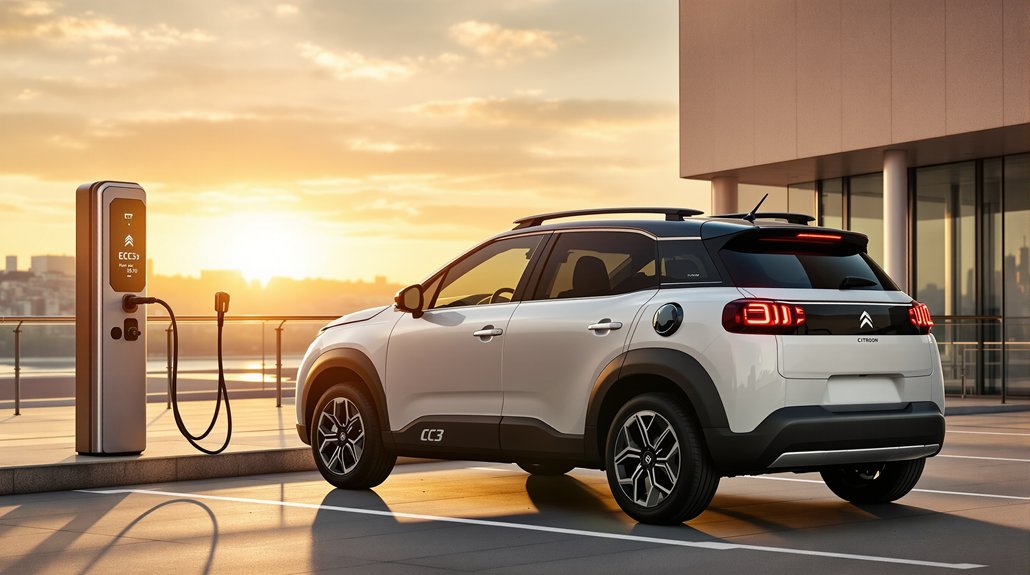Building a robust EV charging infrastructure requires strategic deployment of both public and private charging solutions. Currently, the U.S. has 161,562 charging ports, including 6,409 DC fast-charging stations, but this remains insufficient for projected 2030 demands. While 80% of charging occurs at home, expanding public infrastructure is vital for long-distance travel and urban mobility. Smart charging technologies, wireless solutions, and grid capacity improvements will shape the evolution of this essential network. The path to extensive coverage presents challenges worth exploring.

As the world accelerates toward electric mobility, the development of robust EV charging infrastructure has become increasingly essential for supporting widespread adoption. The United States currently maintains 161,562 public and private charging ports, including 6,409 direct current fast charging stations, yet this represents only a fraction of the infrastructure needed to support projected EV growth by 2030. Time-starved consumers are showing strong preferences for fast-charging options, indicating a willingness to pay premium rates for quicker charging times.
The landscape of charging solutions encompasses various technologies, from basic AC Level 1 residential chargers to high-powered DC fast charging stations. Smart charging solutions empower users with intelligence-driven algorithms to optimize charging schedules and costs. While 80% of EV charging occurs at home, the expansion of public infrastructure remains fundamental for long-distance travel and urban mobility. Current projections indicate a need for 12.9 million charging ports and 140,000 DC fast-charging locations by 2030 to meet growing demand.
Strategic deployment of charging infrastructure requires careful consideration of population density, grid capacity, and accessibility. Urban planners must balance the immediate needs of current EV owners with the anticipated growth of 5-10% EV adoption by 2030.
Smart charging solutions, incorporating load balancing and demand response capabilities, help optimize resource utilization while reducing strain on electrical grids. The challenges of large-scale deployment are substantial, including high installation costs and the need for significant grid upgrades. Wireless charging technology is emerging as a promising solution for the future of EV charging infrastructure.
Integration with renewable energy sources offers promising solutions for reducing carbon footprints and operational costs. Advanced software solutions enable predictive maintenance and remote monitoring, ensuring reliable operation and minimal downtime.
Environmental and economic benefits drive continued investment in charging infrastructure. The expansion aligns with carbon-neutral goals while creating jobs and stimulating economic growth.
Innovative approaches, such as battery swapping stations and scalable designs, provide flexibility for future technological advancement. Success in implementation requires partnerships with industry experts, adherence to standardized regulations, and regular maintenance protocols.
As the charging network grows, the integration of renewable energy sources and smart grid technologies will be imperative for creating a sustainable, efficient charging ecosystem that supports the shift to electric mobility.
Frequently Asked Questions
How Much Does It Cost to Install a Home EV Charging Station?
Home EV charging station installation typically costs between $799-$1,999, varying by complexity and equipment choice.
Level 1 chargers run $300-$600 plus labor, while Level 2 units cost $500-$700 before installation.
Basic installations average $2,500 total, though electrical panel upgrades can push costs beyond $10,000.
Regional labor rates, permit requirements, and distance from electrical panels greatly impact final pricing.
Can Multiple EVS Charge Simultaneously at Public Charging Stations?
Yes, modern public charging stations increasingly support simultaneous charging through power-sharing technology and load balancing systems.
Advanced DC fast chargers like the Noodoe Exceed can serve multiple vehicles concurrently, while dual-port stations efficiently split available power between two EVs.
Smart algorithms optimize power distribution based on vehicle demands and charging speeds, though actual capacity varies by location and infrastructure capabilities.
What Happens if My Car Runs Out of Charge Mid-Journey?
When an EV depletes its battery, the vehicle shuts down completely, requiring assistance to reach a charging point.
Modern EVs provide multiple warnings before this occurs, displaying remaining range and suggesting nearby charging stations.
Roadside assistance services typically offer mobile charging solutions or towing to the nearest station.
While inconvenient, battery depletion doesn’t damage the vehicle’s powertrain, unlike running out of fuel in conventional cars.
Are EV Charging Stations Profitable for Business Owners to Install?
EV charging stations can be profitable investments with proper planning.
Level 2 chargers typically break even within 3-7 years, generating around $28,800 annually at 50% capacity.
DC fast chargers, while requiring higher initial investment ($50,000-$100,000), offer greater revenue potential.
Location critically impacts success, with high-traffic areas achieving 15-35% profit margins.
Government incentives covering up to 50% of installation costs greatly improve ROI calculations.
How Long Do EV Charging Cables and Equipment Typically Last?
EV charging cables typically last 3-5 years under normal conditions, though high-quality models can extend beyond this range. Environmental factors, usage patterns, and maintenance greatly impact longevity.
Charging equipment, including wall-mounted units and pedestals, generally maintains functionality for 7-10 years when properly maintained. Regular inspection of connectors, protective housings, and internal components helps prevent premature failure and guarantees peak charging performance.










14 comments